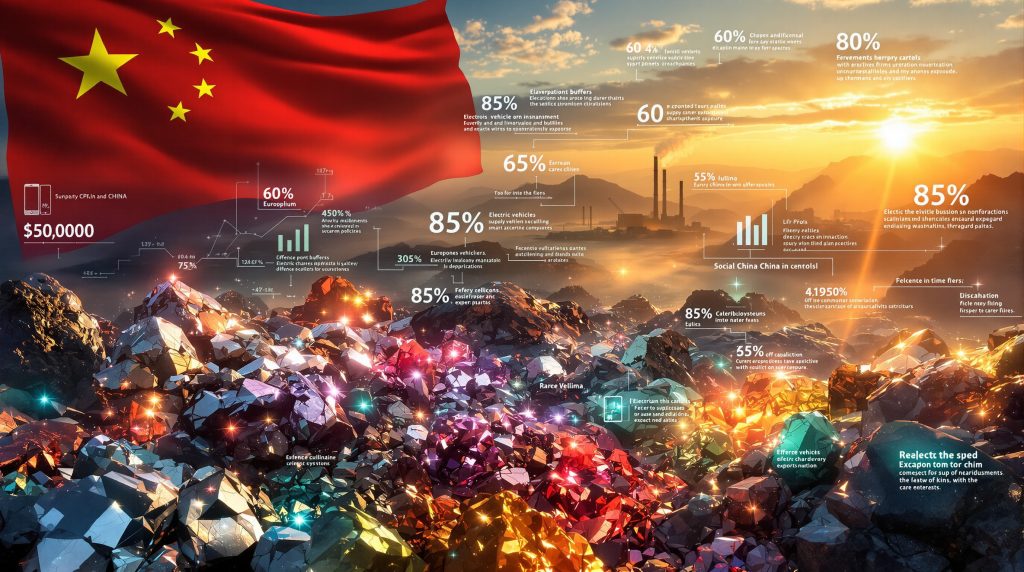China's strategic control over the rare earth export restrictions represents one of the most significant geopolitical leverage points in modern global trade. The nation controls approximately 80% of global rare earth processing capacity, positioning it to influence critical supply chains across defense, technology, and clean energy sectors. This strategic advantage has evolved from decades of deliberate industrial policy designed to consolidate control over materials essential to modern civilization, particularly as the critical minerals transition accelerates globally.
Understanding China's Strategic Weaponization of Rare Earth Resources
The Critical Minerals at the Heart of Global Technology
Rare earth elements encompass 17 chemically similar metallic elements that are fundamental to contemporary technology manufacturing. Despite their name, these materials are relatively abundant in Earth's crust, but their concentration in economically viable deposits remains limited. The challenge lies not in scarcity but in the complex, environmentally intensive processing required to extract usable materials.
Heavy rare earths such as dysprosium, terbium, and holmium are particularly crucial for high-performance applications. Dysprosium, for instance, is essential for permanent magnets in wind turbines and electric vehicle motors, where its unique magnetic properties enable operation at extreme temperatures. Terbium provides the green phosphor in fluorescent lighting and serves as a stabilizer in fuel cells.
Light rare earths including europium, samarium, and gadolinium support different technological applications. Europium creates the red phosphor in LED displays and television screens, while samarium-cobalt magnets maintain performance in aerospace applications where temperature fluctuations would degrade other magnetic materials.
How Export Controls Function as Economic Leverage Tools
Export restrictions operate through sophisticated regulatory mechanisms that extend far beyond simple trade barriers. These controls create cascading effects throughout global supply chains by targeting specific chokepoints where alternatives remain limited or prohibitively expensive to develop rapidly.
The effectiveness of such restrictions stems from structural market dependencies built over decades. Companies worldwide have optimized their supply chains around Chinese processing capabilities, creating switching costs that extend far beyond material prices. Reestablishing processing capacity elsewhere requires substantial capital investment, technological expertise, and regulatory approvals that can span multiple years.
Licensing requirements form the primary control mechanism, allowing selective enforcement based on geopolitical considerations. This approach provides flexibility to maintain exports to cooperative nations while restricting access for others, creating powerful incentives for policy alignment.
Timeline of China's Escalating Mineral Export Policies
China's rare earth export policy evolution reflects broader strategic objectives in global competition. The 2010 dispute with Japan over fishing territory resulted in an informal rare earth export halt that demonstrated the effectiveness of mineral diplomacy. This incident served as a proof of concept for using resource control as geopolitical leverage.
The 2019-2020 period marked a significant escalation in formal export control development. New regulations targeting dual-use technologies began incorporating rare earth processing equipment and specialised alloys. These measures expanded beyond raw materials to include the industrial capacity necessary for downstream processing.
Recent developments indicate further tightening of controls, with extraterritorial provisions affecting how third-party countries can process and re-export Chinese-sourced materials. This approach extends Chinese influence throughout global supply chains, even affecting materials that have already left Chinese territory. Furthermore, this strategy directly impacts energy transition security objectives worldwide.
What Are the New 2025 Rare Earth Export Restrictions?
The latest round of export restrictions represents a comprehensive expansion of Chinese control mechanisms across the rare earth value chain. According to China's expanded export control measures, these measures target not only raw materials but also processing equipment, technical expertise, and finished products containing rare earth components.
Comprehensive Licensing Requirements for Strategic Materials
New licensing frameworks require detailed disclosure of end-use applications, with particular scrutiny applied to defense and dual-use technologies. The approval process involves multiple government agencies and can extend for several months, creating uncertainty for time-sensitive manufacturing schedules.
Enhanced due diligence requirements mandate comprehensive supply chain mapping, forcing companies to reveal their complete operational networks. This transparency requirement provides Chinese authorities with detailed intelligence on global industrial capabilities and vulnerabilities.
Priority allocation systems favour applications aligned with Chinese strategic interests, while potential military or strategic uses face heightened scrutiny. This selective approach allows continued cooperation with compliant partners while restricting access for adversaries.
Extraterritorial Provisions Affecting Global Supply Chains
Perhaps most significantly, new regulations extend Chinese jurisdiction over rare earth materials even after export. Companies processing Chinese-sourced rare earths must comply with Chinese regulations regarding subsequent use and re-export, creating complex compliance obligations that span multiple jurisdictions.
These provisions affect third-country processing facilities that rely on Chinese raw materials. Operations in Malaysia, Vietnam, and other Southeast Asian nations face new restrictions on their ability to serve certain markets, effectively extending Chinese control throughout regional supply chains.
Technology transfer restrictions prevent sharing of Chinese-derived rare earth processing techniques with unauthorised parties. This limitation affects joint ventures and technology partnerships that could otherwise accelerate alternative supply chain development, particularly hindering advanced extraction techniques.
Key Materials Under Enhanced Control Measures
The restriction scope encompasses both raw rare earth elements and downstream products. Permanent magnets, specialised alloys, and electronic components containing restricted materials now face export licensing requirements based on their rare earth content and intended applications.
| Material Category | Specific Elements | Primary Applications | Control Level |
|---|---|---|---|
| Heavy Rare Earths | Dysprosium, Terbium, Holmium | Defence systems, EVs | Strict licensing |
| Light Rare Earths | Europium, Samarium, Gadolinium | Electronics, magnets | Moderate licensing |
| Processing Equipment | Mining technology, refining systems | Industrial production | Immediate controls |
| Finished Products | Permanent magnets, alloys | Commercial applications | Value-threshold based |
Processing equipment restrictions target the industrial machinery necessary for rare earth refinement and separation. This approach addresses the fundamental bottleneck in alternative supply chain development by limiting access to the specialised technology required for processing operations.
How Do These Restrictions Impact Global Supply Chains?
Export restrictions create immediate disruptions across industries dependent on rare earth inputs, with effects varying based on inventory levels, supply diversification, and substitution possibilities. The interconnected nature of global manufacturing means that disruptions propagate quickly through supplier networks.
Manufacturing Disruptions Across Critical Industries
Electric vehicle manufacturers face the most immediate pressure due to their dependence on rare earth permanent magnets for motor systems. These magnets require specific rare earth compositions that cannot be easily substituted without significant performance degradation or design modifications.
Wind turbine production confronts similar challenges, with dysprosium-enhanced magnets essential for offshore installations where maintenance accessibility is limited. The specialised metallurgy required for these applications creates high barriers to alternative sourcing.
Defence contractors experience supply chain vulnerabilities across multiple weapon systems. F-35 fighter jets require rare earth elements in their radar systems, electronic warfare equipment, and guidance systems. The precision requirements for military applications often prevent the use of substitute materials that might be acceptable in commercial products.
Price Volatility and Market Uncertainty Factors
Rare earth prices exhibit extreme volatility during supply disruptions due to the inelastic nature of demand and limited substitution options. Price increases of 300-500% occurred during previous export restrictions, with heavy rare earths experiencing more severe inflation than light rare earth elements.
Market speculation amplifies price volatility as traders anticipate future supply constraints. Financial markets for rare earth futures and related equity securities become increasingly divorced from underlying supply-demand fundamentals during periods of geopolitical tension.
Long-term supply contracts provide some price stability but often include force majeure clauses that allow suspension during export restrictions. This contractual vulnerability leaves manufacturers exposed to spot market volatility during critical periods.
Alternative Sourcing Challenges for International Companies
Developing alternative supply sources faces significant technical and economic barriers. Rare earth processing requires specialised expertise that exists primarily within Chinese industrial networks, creating knowledge gaps that cannot be quickly bridged through capital investment alone.
Environmental regulations in Western nations complicate alternative processing development. The toxic byproducts of rare earth separation create regulatory hurdles that can extend project timelines by several years while increasing capital costs substantially.
Industries most affected by rare earth restrictions face 60-90 day supply buffers before critical shortages emerge. Electric vehicle manufacturers report the highest exposure, with 85% of permanent magnet requirements sourced from Chinese-controlled facilities.
Which Industries Face the Greatest Risk from Export Controls?
The impact of rare earth export restrictions varies significantly across sectors based on their dependence on specific elements, availability of substitutes, and strategic importance to national security. Understanding these vulnerabilities helps identify which industries require priority attention for supply chain resilience.
Defence and Aerospace Manufacturing Dependencies
Military applications represent the highest-risk category due to stringent performance requirements and limited tolerance for supply interruptions. Advanced radar systems require precise rare earth compositions that maintain consistent performance across extreme temperature and electromagnetic environments.
Guidance systems in precision weapons rely on rare earth magnets for their compact size and reliability. The miniaturisation requirements for modern military equipment often prevent the use of alternative magnetic materials that would increase size and weight substantially.
Satellite systems incorporate rare earth elements in their communication arrays and power management systems. The harsh space environment demands materials that maintain performance over decades without maintenance, limiting substitution options to proven rare earth-based solutions.
Electric Vehicle and Clean Energy Sector Vulnerabilities
The transition to clean energy technologies has created unprecedented demand for rare earth elements, particularly in permanent magnet applications. Electric vehicle motors require high-performance magnets that maintain efficiency across wide temperature ranges while minimising size and weight.
Offshore wind installations present particular vulnerability due to their dependence on direct-drive generators using rare earth permanent magnets. The maintenance challenges of offshore environments necessitate highly reliable magnetic systems that can operate for decades without service.
Solar panel manufacturing utilises rare earth elements in specialised glass coatings and electronic components. While individual panels contain relatively small quantities, the scale of solar deployment creates significant aggregate demand that stresses supply chains during restrictions.
Consumer Electronics Production Challenges
Smartphone and tablet manufacturing relies on rare earth elements for displays, speakers, and vibration systems. The competitive pressure for miniaturisation and performance enhancement makes substitution particularly challenging without compromising consumer expectations.
Television and display manufacturing faces disruptions in phosphor supply, affecting colour accuracy and energy efficiency. LED lighting systems similarly depend on rare earth phosphors for colour spectrum control and efficiency optimisation.
Hard drive manufacturing represents a critical chokepoint in data storage infrastructure. The precision magnetic systems required for high-capacity storage rely on specific rare earth compositions that maintain data integrity and access speed.
What Strategic Response Options Are Available to Affected Nations?
Nations facing rare earth supply constraints possess several strategic response mechanisms, though each approach requires significant time and resources to implement effectively. The optimal response typically involves a combination of domestic development, international partnerships, and technological innovation.
Domestic Mining Development and Processing Capabilities
Geological surveys indicate substantial rare earth deposits outside China, with Australia, Canada, and the United States possessing significant identified resources. However, transforming mineral resources into operational supply chains requires extensive capital investment and technical expertise development.
The Mountain Pass facility in California demonstrates both the potential and challenges of domestic rare earth production. While the mine successfully extracts rare earth concentrate, establishing downstream processing capabilities requires additional specialised infrastructure and environmental approvals.
Processing technology development represents a critical bottleneck in supply chain independence. The complex chemical separation processes required for rare earth purification involve proprietary techniques that must be developed through substantial research and development investment.
International Partnership Frameworks for Resource Security
Multilateral cooperation agreements enable resource sharing and risk distribution among allied nations. The Critical Minerals Partnership between the United States, Australia, and Canada creates framework for coordinated resource development and supply chain integration.
Technology sharing arrangements accelerate processing capability development by distributing research costs and expertise. Joint ventures between mining companies and research institutions create knowledge networks that reduce individual nation dependencies on Chinese technical expertise, particularly relevant for Greenland critical minerals development.
Strategic stockpiling through international reserve coordination provides buffer capacity during supply disruptions. Coordinated release policies ensure that stockpile drawdowns support market stability rather than creating additional volatility through uncoordinated actions.
Technology Innovation and Material Substitution Strategies
Advanced materials research focuses on developing alternatives to rare earth-dependent technologies. Permanent magnet research investigates iron-nitride and other compositions that could provide similar performance characteristics without rare earth content.
Recycling technology advancement offers potential to reduce primary mining dependence through urban mining of electronic waste. Current recycling rates for rare earth elements remain below 5% of total consumption, indicating substantial improvement potential.
Nations can respond to rare earth restrictions through: (1) Strategic mineral reserves establishment, (2) Alternative supplier development programs, (3) Research investments in substitute materials, (4) Coordinated international policy responses, and (5) Industrial policy measures including price floors and equity stakes.
How Are Major Economies Responding to China's Export Restrictions?
Global responses to Chinese rare earth dominance reflect diverse national priorities and capabilities, with each major economy developing tailored approaches based on their industrial base, resource endowments, and strategic objectives.
United States Industrial Policy and Strategic Mineral Initiatives
The Defence Production Act provides legal framework for government intervention in strategic mineral supply chains. This authority enables direct investment in domestic processing capabilities while ensuring priority allocation for defence applications during shortages.
Tax incentives and loan guarantees support private sector investment in rare earth processing infrastructure. The Infrastructure Investment and Jobs Act allocated substantial funding for critical mineral processing facilities while providing regulatory streamlining for strategic projects.
The Pentagon's approach to supply chain security increasingly involves direct equity participation in strategic suppliers. This model ensures supply continuity while providing government oversight of critical industrial capabilities.
The Pentagon's unprecedented equity stake arrangement with MP Materials demonstrates how governments can secure supply chain resilience through direct investment, price floor guarantees, and long-term offtake agreements.
European Union Critical Raw Materials Act Implementation
The Critical Raw Materials Act establishes comprehensive framework for supply chain resilience across the European Union. This legislation mandates diversification targets while providing funding mechanisms for domestic processing capacity development.
Strategic partnership agreements with resource-rich developing nations create preferential access arrangements while supporting local economic development. These partnerships often include technology transfer and infrastructure investment components that benefit both parties.
Circular economy initiatives emphasise recycling and urban mining to reduce import dependence. The EU's Batteries Regulation mandates recycling content targets that create demand for domestic rare earth recovery capabilities.
G7 Coordinated Response and Alliance Building Efforts
Minerals Security Partnership coordinates resource development among allied nations while pooling technical expertise and financial resources. This multilateral approach distributes investment risks while accelerating project timelines through shared capabilities.
Joint research initiatives focus on alternative materials development and processing technology advancement. Coordinated funding mechanisms ensure that research benefits are shared among participating nations while avoiding duplication of effort.
Trade policy coordination creates unified responses to export restrictions while maintaining pressure for fair market practices. However, as noted by trade experts, synchronised tariff and investment policies amplify individual nation leverage in bilateral negotiations.
What Are the Long-Term Implications for Global Trade Relations?
The weaponisation of rare earth export restrictions represents a fundamental shift in international economic relationships, moving beyond traditional trade disputes toward systematic use of resource dependencies for geopolitical objectives.
Geopolitical Leverage and Economic Statecraft Evolution
Resource diplomacy is becoming increasingly sophisticated, with nations using supply chain dependencies to influence foreign policy decisions. This approach extends beyond bilateral relationships to affect multilateral organisations and international governance structures.
Alliance structures are adapting to incorporate resource security considerations alongside traditional military and diplomatic cooperation. Supply chain resilience is becoming a core component of national security planning and international partnership agreements.
The normalisation of industrial policy across Western economies reflects recognition that market mechanisms alone cannot ensure strategic resource access. Government intervention in critical supply chains is becoming accepted practice rather than exceptional response.
Supply Chain Regionalisation and Friend-Shoring Trends
Regional blocs are emerging around shared resource security interests, with nations prioritising trade relationships that enhance rather than compromise strategic autonomy. These arrangements often supersede purely economic efficiency considerations, as demonstrated by the Australia strategic reserve initiative.
Near-shoring initiatives relocate production closer to end markets while reducing dependence on potentially adversarial suppliers. This geographic rebalancing requires substantial infrastructure investment but provides enhanced supply chain control.
Trusted supplier networks create preferential access arrangements among allied nations while establishing higher barriers for non-aligned suppliers. These networks often include technology sharing agreements that accelerate mutual capability development.
Technology Decoupling Acceleration Across Critical Sectors
Standards divergence is accelerating as competing economic blocs develop separate technical requirements and certification processes. This fragmentation increases compliance costs while creating barriers to technology transfer.
Research collaboration restrictions limit academic and commercial cooperation in strategic technologies. These limitations affect innovation rates while creating duplicate research efforts across competing blocs.
Investment screening mechanisms increasingly target acquisitions and partnerships that could create strategic vulnerabilities. Foreign direct investment approval processes now incorporate supply chain security considerations alongside traditional economic factors.
How Can Companies Mitigate Rare Earth Supply Chain Risks?
Corporate risk management strategies must balance cost efficiency with supply chain resilience, requiring sophisticated approaches that account for both immediate operational needs and long-term strategic positioning.
Diversification Strategies for Critical Material Sourcing
Multiple supplier relationships provide insurance against single-source disruptions while creating competitive pressure for pricing and service. However, diversification in rare earth markets faces practical limitations due to concentrated global processing capacity.
Geographic distribution of supply sources reduces exposure to regional political instability or natural disasters. Companies increasingly evaluate suppliers based on political stability and regulatory predictability rather than purely economic factors.
Vertical integration opportunities enable greater supply chain control through direct investment in mining and processing operations. This approach requires substantial capital commitment but provides enhanced security for critical inputs.
Inventory Management and Strategic Stockpiling Approaches
Strategic inventory levels must balance carrying costs against supply disruption risks. The optimal inventory duration depends on supplier diversification, substitution possibilities, and demand volatility characteristics.
Risk-adjusted procurement involves paying premiums for enhanced supply security through longer-term contracts or preferred supplier relationships. These arrangements often include minimum purchase commitments in exchange for guaranteed access during shortages.
Financial hedging instruments can provide protection against price volatility while ensuring budget predictability. However, rare earth futures markets remain relatively illiquid, limiting hedging effectiveness for many companies.
Investment in Recycling and Circular Economy Solutions
Urban mining initiatives recover rare earth elements from electronic waste streams, creating alternative supply sources while addressing environmental objectives. Technology advancement in recycling efficiency continues to improve economic viability.
Product design optimisation reduces rare earth content while maintaining performance characteristics. This approach requires substantial research and development investment but provides long-term supply chain independence.
Closed-loop manufacturing systems capture and reprocess rare earth elements within production facilities, minimising external supply dependence. These systems require sophisticated separation and purification capabilities but offer significant cost advantages at scale.
| Strategy | Implementation Time | Capital Investment | Risk Reduction |
|---|---|---|---|
| Alternative suppliers | 18-36 months | $50-200M | 40-60% |
| Recycling facilities | 24-48 months | $100-500M | 20-35% |
| Material substitution | 36-60 months | $200M-1B | 60-80% |
| Strategic stockpiling | 6-12 months | $10-50M | 30-50% |
What Does the Future Hold for Rare Earth Market Dynamics?
The rare earth market is undergoing fundamental structural changes driven by geopolitical competition, technological advancement, and environmental considerations. These forces will reshape supply chains, pricing mechanisms, and competitive dynamics over the coming decade.
Emerging Producer Nations and Market Diversification Potential
Australia's rare earth development accelerates through government support and private investment, with multiple projects advancing toward production. The Lynas facility in Western Australia demonstrates viable alternatives to Chinese processing, though scaling remains challenging.
African mineral resources present significant long-term potential, with Tanzania, Madagascar, and South Africa possessing substantial rare earth deposits. However, infrastructure limitations and political instability create implementation challenges that require sustained international support.
Canadian mining projects benefit from political stability and established mining expertise, though environmental regulations and community relations create development complexities. The Vital Metals and other companies are advancing projects that could contribute meaningfully to North American supply security.
Technological Breakthroughs in Processing and Recycling
Advanced separation technologies promise to reduce the cost and environmental impact of rare earth processing. Solvent extraction improvements and ion exchange innovations could make smaller-scale processing operations economically viable.
Artificial intelligence applications optimise processing parameters and predict equipment maintenance needs, improving efficiency while reducing operational costs. These technologies particularly benefit complex separation processes where small parameter adjustments significantly affect outcomes.
Biotechnology approaches utilise engineered organisms to concentrate and separate rare earth elements from low-grade ores. While still in development, these technologies could revolutionise processing economics by reducing energy requirements and toxic byproduct generation.
Policy Evolution and International Regulatory Frameworks
World Trade Organisation discussions increasingly focus on export restrictions and their compatibility with international trade law. However, enforcement mechanisms remain limited when restrictions involve national security justifications.
Bilateral trade agreements increasingly incorporate provisions addressing critical mineral access and supply chain transparency. These agreements often include technology sharing and investment protection measures that facilitate alternative supply development.
Environmental standards harmonisation could create common regulatory frameworks that facilitate international cooperation in rare earth processing while ensuring environmental protection. However, differences in environmental priorities and capabilities complicate standardisation efforts.
What will be the immediate impact on global supply chains?
Historical precedent suggests 2-5 years, depending on geopolitical negotiations and alternative supply development.
Can recycling replace primary rare earth mining?
Current recycling meets only 1% of global demand, though technology advances could increase this to 20-30% by 2035.
Which countries have the largest untapped rare earth reserves?
Australia, Brazil, Canada, and several African nations possess significant undeveloped deposits outside Chinese control.
Investment Implications and Market Opportunities
The restructuring of rare earth supply chains creates substantial investment opportunities while introducing new risk factors that require careful evaluation. Market dynamics are shifting from purely commodity-based pricing toward strategic premium valuations.
Rare Earth Mining Stock Performance and Valuation Metrics
Equity valuations for rare earth mining companies increasingly incorporate strategic value premiums beyond traditional commodity pricing models. Companies with domestic processing capabilities command higher valuations than pure extraction operations.
Revenue visibility improves for companies with long-term government contracts and strategic partnerships. The Pentagon's equity stake model provides valuation benchmarks for similar arrangements while demonstrating government commitment to supply chain security.
Operational risks require enhanced due diligence regarding environmental compliance, community relations, and technical expertise. The complexity of rare earth processing creates execution risks that traditional mining investment models may underestimate.
Critical Minerals ETF and Commodity Investment Vehicles
Exchange-traded funds focusing on critical minerals provide diversified exposure while reducing single-company risks. These vehicles typically emphasise companies with strategic government relationships and domestic processing capabilities.
Commodity futures markets remain relatively underdeveloped for rare earth elements, limiting direct commodity investment options. Most exposure remains through equity securities of mining and processing companies.
Physical commodity storage faces practical challenges due to the specialised handling requirements and market illiquidity of rare earth elements. Investment funds typically maintain exposure through long-term supply contracts rather than physical holdings.
Government Incentive Programs for Strategic Material Companies
Tax incentives and accelerated depreciation provisions support private investment in domestic processing infrastructure. These programmes often include performance requirements related to domestic content and supply chain transparency.
Research and development grants facilitate technology advancement while sharing development risks between government and private investors. Successful technology development often leads to exclusive licensing arrangements that provide competitive advantages.
Guaranteed purchase agreements reduce market risk for new processing facilities while providing predictable revenue streams. These arrangements typically include price floors and volume commitments that support project financing.
Investment decisions involving rare earth companies and critical minerals should consider the speculative nature of supply chain development, geopolitical risks, and the extended timelines required for project implementation. Market conditions and government policies may change significantly during development periods, affecting project viability and returns.
Looking to Navigate the Rare Earth Investment Landscape?
Discovery Alert's proprietary Discovery IQ model provides instant notifications on significant ASX mineral discoveries, helping investors identify critical minerals opportunities before broader market recognition. With rare earth supply chain disruptions creating new investment dynamics, stay ahead of emerging opportunities by exploring Discovery Alert's discoveries page to understand how historic mineral discoveries have generated substantial returns.




